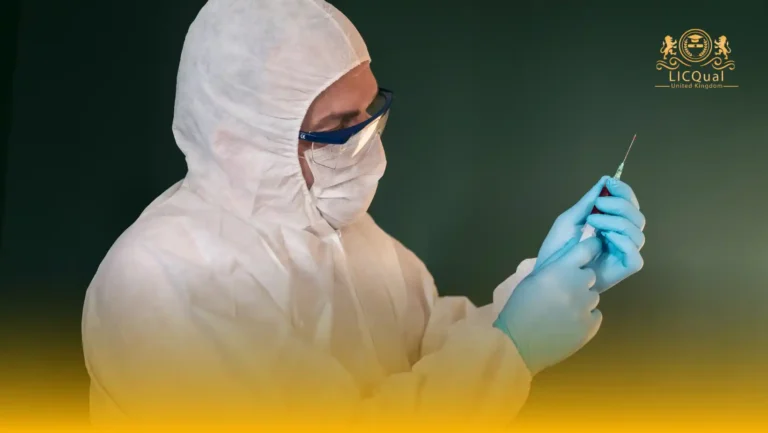The LICQual Level 3 Award in Paediatric First Aid (PFA) is a comprehensive certification designed to equip parents, childcare providers, and early years professionals with the essential skills needed to respond confidently and effectively to paediatric emergencies. This internationally recognized qualification focuses on both emergency response and ongoing care for infants and young children, ensuring that learners are prepared to act swiftly to safeguard children’s health and wellbeing.
The course covers vital first aid techniques including CPR, managing choking, treating burns, cuts, fractures, and responding to common childhood illnesses and injuries. With a strong emphasis on practical, hands-on training and real-life scenarios, learners develop the confidence and competence to provide effective first aid care in home, childcare, and educational settings.
Participants will gain a thorough understanding of paediatric first aid principles, including how to assess emergencies, perform life-saving interventions, and communicate with healthcare professionals and caregivers. Upon successful completion, learners will be qualified to provide paediatric first aid that meets national and international standards, enhancing safety in all child-focused environments. This course is ideal for anyone responsible for the care of children, from parents to childcare workers and educators.
Course Overview
Qualification Title
LICQual Level 3 Award in Paediatric First Aid (PFA)
Total Units
6
Total Credits
6
GLH
12
Qualification #
LICQ2200600
Qualification Specification
To enroll in the LICQualLevel 3 Award in Paediatric First Aid (PFA) applicants must meet the following criteria:
|
Qualification# |
Unit Title |
Credits |
GLH |
|---|---|---|---|
|
LICQ2200600-1 |
Introduction to Paediatric First Aid |
1 |
6 |
|
LICQ2200600-2 |
Assessing the Situation and Initial Response |
1 |
6 |
|
LICQ2200600-3 |
Managing Unconsciousness and Recovery Position |
1 |
6 |
|
LICQ2200600-4 |
Cardiopulmonary Resuscitation (CPR) for Infants and Children |
1 |
6 |
|
LICQ2200600-5 |
Dealing with Common Paediatric Injuries and Illnesses |
1 |
6 |
|
LICQ2200600-6 |
Recording, Reporting, and Legal Considerations |
1 |
6 |
By the end of this course, learners will be able to:
Unit 1: Introduction to Paediatric First Aid
- Explain the purpose and importance of paediatric first aid.
- Describe the roles and responsibilities of a paediatric first aider.
- Identify key anatomical differences between infants, children, and adults relevant to first aid.
Unit 2: Assessing the Situation and Initial Response
- Demonstrate how to assess an emergency scene for safety risks.
- Prioritize actions to protect themselves, the casualty, and bystanders.
- Identify when and how to call for professional medical assistance.
Unit 3: Managing Unconsciousness and Recovery Position
- Recognize signs and symptoms of unconsciousness in infants and children.
- Correctly place an infant or child in the recovery position to maintain airway patency.
- Monitor and reassess casualty’s breathing and condition while waiting for emergency services.
Unit 4: Cardiopulmonary Resuscitation (CPR) for Infants and Children
- Perform chest compressions and rescue breaths effectively on infants (under 1 year).
- Perform CPR procedures correctly on children (1 year to puberty).
- Demonstrate knowledge of the use and importance of AEDs in paediatric resuscitation.
Unit 5: Dealing with Common Paediatric Injuries and Illnesses
- Identify common paediatric emergencies such as choking, bleeding, burns, fractures, asthma attacks, allergic reactions, and seizures.
- Apply appropriate first aid techniques to manage these injuries and illnesses safely.
- Explain when to escalate care and seek emergency medical assistance.
Unit 6: Recording, Reporting, and Legal Considerations
- Accurately record incident details and first aid treatment provided.
- Understand the importance of confidentiality and data protection in paediatric first aid.
- Explain legal responsibilities, safeguarding principles, and consent related to paediatric first aid.
This course is ideal for:
- Childcare Professionals:
- Nursery staff, preschool teachers, childminders, and daycare workers who care for infants and young children.
- Parents and Guardians:
- Mothers, fathers, and primary caregivers wanting to gain essential first aid skills for their children’s safety.
- Healthcare Assistants and Support Workers:
- Those working in paediatric wards, clinics, or community health settings requiring certified paediatric first aid knowledge.
- Teachers and School Staff:
- Primary and early years educators responsible for the health and safety of children during school hours.
- Youth Workers and Coaches:
- Individuals working with children in sports, clubs, or recreational activities who need to respond effectively in emergencies.
- Volunteers in Child-focused Organizations:
- Volunteers engaged in camps, clubs, or charities involving children and young people.
- Anyone Interested in Paediatric Safety:
- Individuals who want to be prepared to respond confidently and competently in paediatric emergencies
Assessment and Verification
All units within this qualification are subject to internal assessment by the approved centre and external verification by LICQual. The qualification follows a criterion-referenced assessment approach, ensuring that learners meet all specified learning outcomes.
To achieve a ‘Pass’ in any unit, learners must provide valid, sufficient, and authentic evidence demonstrating their attainment of all learning outcomes and compliance with the prescribed assessment criteria. The Assessor is responsible for evaluating the evidence and determining whether the learner has successfully met the required standards.
Assessors must maintain a clear and comprehensive audit trail, documenting the basis for their assessment decisions to ensure transparency, consistency, and compliance with quality assurance requirements.







